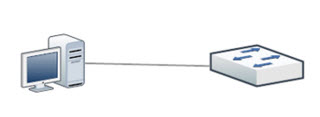CCNA, CCENT, Network+ Tutorial: Ethernet Standards And Speeds
In the previous installments of this CCNA and Network+ tutorial series, we took a look at the two major networking models — the OSI and TCP/IP models, to be exact. Now it’s time for a look at the cables that make our networks possible.
Whether it’s host-to-switch…

… or switch-to-switch…

… or switch-to-router…

… we’re using Ethernet and Ethernet-based cables to make our L1 connection happen. In this section, we’ll take a look at a few of the Ethernet standards and cable types we use to lay the physical foundation for our network. “Ethernet” is really an umbrella term, encompassing different speeds and capacities. Before we get to the cable types, let’s talk a bit about the wires inside those cables.
Most of today’s Ethernet cables are unshielded twisted-pair (UTP), where the wires inside are pairs of twisted copper cables. Twisting the cables minimizes the effect of electromagnetic interference (EMI) from outside sources ranging from other cables to elevators. The twist also lessens the amount of EMI emanating from the cable itself.
I was once the network admin for a building where many network cables were run right next to an elevator shaft. Every day at lunchtime and quitting time, our network got the shaft due to the EMI from the elevator.
We can run into EMI problems from wires in the same cable. Crosstalk occurs when a signal “crosses over” from one pair of wires to another in a single cable, making the signals in both pairs of wires unusable.
Since we have unshielded twisted pair, it follows that we’d have shielded twisted pair (STP). The shielding is wrapped around each individual wire, and then additional shielding is wrapped around each pair of those same wires. Sounds great, right? STP is great in theory, but the reality is another matter. Even slightly damaged shielding can introduce additional EMI. STP is more easily damaged than is UTP, and STP costs more. For these reasons, you don’t bump into a lot of STP these days.
We leave behind such problems when we make a move from copper cables to fiber optic cabling, which contains glass fibers that allow for greater transmission speeds and much greater max cable lengths. With those advantages, you just know there’s a reason we’re not using it everywhere we can. The problem: Fiber optic is still much more expensive than copper.
Speaking Of Speeds (And Lengths)
Here’s important information on common and not-so-common Ethernet standards, including their official IEEE name and the name network admins use for them. All copper standards below have a maximum cable length of 100 meters. This is good stuff to know.
Copper-based standards:
Ethernet runs at 10 Mbps. The official standard is 802.3, commonly known as 10BASE-T. Uses two pairs of wires out of the four available.
Then came Fast Ethernet, clocking in at 100 Mbps. The IEEE standard is 802.3u, while you and I call it 100Base-T. Uses two pairs of wires out of the four available.
After that came Gigabit Ethernet, bringing 1000Mbps speed to the table. Now we’re getting somewhere! Known as 1000-BaseT to you and me, the IEEE standard is 802.3ab. The speed is possible in part because all four pairs of wires in the cable are used.
You will not be surprised to learn that 10 Gig Ethernet runs at 10 Gbps (Gigabits per second). We call it 10GBase-T; the IEEE calls it 802.3an.
Fiber standards jump straight to Gigabit Ethernet, running at 1000 Mbps. Network admins call it 1000Base-LX, while the official IEEE standard is 802.3z.
You will not be surprised to learn that 10 Gig Ethernet runs at 10 Gbps (Gigabits per second). We call it 10GBase-T; the IEEE calls it 802.3an.
Fiber standards jump straight to Gigabit Ethernet, running at 1000 Mbps. Network admins call it 1000Base-LX, while the official IEEE standard is 802.3z.
Why Do We Need Ethernet Standards?
When an Ethernet frame goes from Point A to Point B, there’s a chance the frame will travel over links that have different capacities.

If the switches had to do some kind of translation every time a frame went from a link with one Ethernet standard to a link using another Ethernet standard, they’d be doing a lot of translating. That would result in a great deal of extra work for the switches, not to mention slowing down the overall Point A-to-Point B transmission. Thankfully, no such translation is necessary, since the different Ethernet standards use the same frame format.

Header. Data. Trailer. Simple!
You’ll also find the cable types needed for the various hardware connections to be simple once you read the next installment of this CCNA and Network+ tutorial series. When you’re done here, be sure to head out to my YouTube channel, as I just began a new series of CCNA Video Practice Exams you don’t want to miss!
Chris Bryant’s CCNA And Network+ YouTube Channel
Speaking of videos, my CCNA Video Boot Camp has been helping students just like you earn their CCNA for well over a decade. Come on out and join us today!
Chris Bryant’s CCNA Video Boot Camp
As always, thanks for making my work a part of your success!






